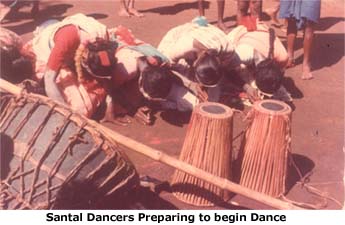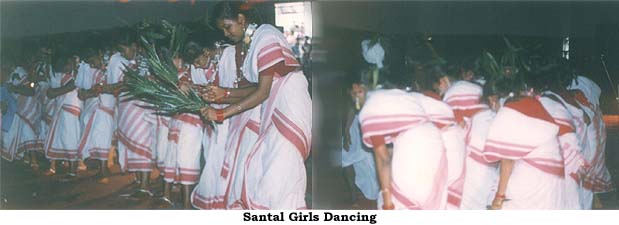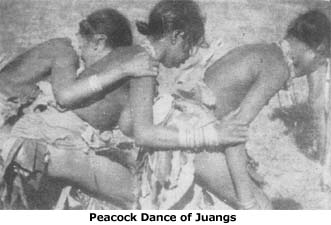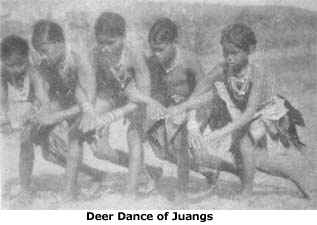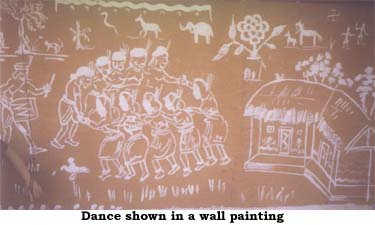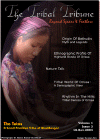Rhythm in the Hills; Tribal Dances Of Orissa
|
Bonda Dance is natural expression of joy performed by individual or group through patterned movement of body parts along with music to make it more enjoyable to viewers. In complex society, dancers perform to entertain their patron, but tribal people, dance for themselves. Their dances are never solo for this reason. All the community members enjoy dancing either as performer or as viewer. Although W.G. Archer in his book "The Hill of Flutes" (1974) mentioned ‘nude joker’ solo dances of the Santal, this may be an exception. The tribal people, who toil in the hills and dense forest habitats for their livelihood, enjoy their leisure through dance with music and home brewed drink. A visitor of tribal land may be charmed by drum and flute sound of dance after dusk, which may continue till wee hours around the community fire. Songs are also sung in chorus. From choreography to lyric and musical instruments, everything is indigenous. It is not that dances are performed only during night; many ceremonial dances are organized in daylight also.
Scholars and amateurs are equally interested about tribal dance because it has not only given origin to complex dances of modern society but also depicts complex theme through simple expression. The present discussion will be limited to some form of dances still prevalent among some primitive tribal communities of Orissa (part of Eastern India). Tribal dances are of various forms, various themes and various purposes. Many dances when analyzed lead one to believe that they originated at very early stage of human existence i.e. hunting and gathering using stone implements. Later with modification of subsistence economy, the dance form changed keeping some ancient items as well as dramatic expressions. Various forms of their economic pursuit like digging up root-tubers, collection of flowers, fruits and wood or snaring and hunting animals on land or water or cultivation of crops, make them exposed to Nature. They pose many problems and the people make efforts to win over the difficulties. Such encounters are dramatized in the form of rhythmic expressions with music at their home sites. These are enjoyed as entertainment. Broadly the tribal dances can be categorized as (i) orderly movement and (ii) disorderly movement of the troupe. The hunter band operates either in a file or disorderly, for chasing a game animal, but adhere to certain planned movements to encircle the animal. In dance also such moves are noticed. Various animals and forest birds are hunted. These fauna also cause damage to their crops. The dancers imitate behaviors of these animals. The Kesari Kappa dance of the Oraon tribe (Orissa and Jharkhand) depicts collection of ‘Kesari Fruit’ (growing in marshy land) by the women. The dancing girls kneel down enacting the collection while the drummers squat before theme. The Koya (Orissa and Andhra Pradesh) people perform a dance during marriage, where both man and women move in orderly files. Each male dancer holds an iron rod with a tiny cap, which produces sound on jerk. This rod represents the multipurpose stick used by ancient tuber diggers which was male job while the women collected the tubers. In various dances bear, tiger, deer, snake, fowls, crane, etc find place, as these are very much associated with their daily life.
Another stage is represented by group dance arranged in disorderly lines. This type of disorderly movement of dances probably developed in Mesolithic period, when these people lived on hunting. When the ‘kill’ was brought to dwelling site, the women in group would go forward to welcome their men and made a procession with the ‘kill’. This ‘Procession Dance’ now performed in orderly manner, by the Khond tribe during various occasions like marriage or brining the sacrificial pole from the forest for meria (originally a human sacrifice festival, now replaced with buffalo) . The Lanjia Saora (so named for wearing a loin cloth leaving excess at the back looking as tail) also performs such procession dance during their festival for eating new crop.
Many primitive tribes with hunting tradition (Bonda, Saora, Khond) have incorporated many incidents of past, following successful hunting, in their dances. For example, the hunter-bands often indulged in petty quarrel among themselves over claim for major share of meat. They became intoxicated and sometimes the verbal abuse leads to brawl even capture of women for rival factions. In the present dances, such incidents are dramatized. The dancers shout, shriek and feign fight or capture with rhythm enhancing drum beating. There are much similarities of this dance among the above-mentioned Mundari dialect speakers. The file type of dance depicting hunting is not with disorderly movement. The dancers in a file show zigzag movements with high speed, imitating search and chase of game animals. They do not exhibit rhythmic movement of limbs. Gradually, this file type of dance transformed into procession type among the Bonda, Khond etc. In the Bonda dance, a group of girls stand in the center around whom a file of men dancers move encircled by rushing drummers and elderly women in procession form. This Bonda dance though lack many other aspects, yet prove to be a missing link between the ‘file’ and ‘procession’ pattern in the process of evolution of dances among the tribal population. The procession type of dance got further refined probably in the new Stone Age (when people learnt cultivation). It became associated with bone immersion ceremony. Such refinements are found among Santal, Kol and Munda (also found to live in Jharkhand). A further developed stage of this procession type is observed among the Bonda, Koya, Godaba tribes (of undivided Koraput district of Orissa) when they carry the large monobloc stone to be used as grave-marker, after quarrying. This is an arduous task, but performed for the honor of the dead. This large stone is carried to the burial ground in a procession with dance.
It was reported that six girls each took a long strip of white cloth and winding it around their waist, allowed one hand to hang in the back to resemble tail of a peacock. The dancing girls stand in two rows face to face with left hands resting on their hips and elbows protruding out to mean wings of the bird. Their right hand outstretched forward to mimic neck and head of a peacock. Then they start forward and backward, crossing each other, with heels occasionally clashing against each other. The girls look downward, but move with beats and trumpet blows. The music men keep up the spirit of the dancers. The Juang people probably learnt this dance from the Khond, whose dance modified in course of time. This dance initially was without musical instruments. Later when the villages developed, musical instruments came to be accompanied, along with dress and hair do of the dancing maids.
The dances of Oraons consist of three stages commencing with Jadur. This is arranged to seek life-partner. The second stage is Sarhul dance organized at the end of the spring for the celebration of marriage. The last stage is Kharia dance during the Phagu festival to seek blessings for the newly wed. In our view, these dances were originally designed for agricultural success. The step-wise dances commemorates the dead for good crops, to begin the agricultural cycle with their blessing and anticipating good harvest. This is also the general norm for other similar tribes like Kol, Ho, Santal, Munda, etc. The Jadur dance in general is composed of long line up maidens holding each other, facing similar row of young boys. The gender wise lines move fo ward and retreat with coordinated steps alternately i.e. when the boys step forward, the girls step back. The drumbeater puts rhythm in the movements. The Santal Dance Lagre is almost similar to Oraon Jadur dance. The Tahri dance of Santal, arrange the girls troupe in a curve line facing the drummers. They start the dance with jerking oscillation and sing along the beat of drum. The feet movements are side-wise, i.e. the left foot moves forward but keep leftwards. Then the right foot is brought near it, the same is repeated with right in next move. The hands sway and the buttocks roll, head also move in nodding gesture. The song rises and falls in tune. This type of choreography developed in through time and gives an enjoyable view.
The Kharia tribals perform a dance similar to village opera (Jatra) where men and women mix up in a column and behind the other. Each dancer extends one hand forward and one hand backward to clap the hands of other dancers in front and behind. This dance has structural similarity with Jadur dance, but differ in filing manner and interlocking of hands. The Phagu Shikar is pantomimic representation of hunting. The dancers hold sticks, clubs etc and step movements represent chase, running as done in hunting. Such dances remind one about the Koya or Kondh marriage dances, reflecting hunter’s way of life in bygone days. The Oraon tribe performs Karam dance representing agricultural practices. In this dance, the men and women arrange themselves in separate groups. The postures are different and movements are slow but graceful. The men dancers in course of movements kneel down and each girl stoop low before them swaying their hands forward and backward, as if reaping paddy from the field. At the end all dancers exclaim! The Bhuinya and Juang (Central Orissa) have dances of their own peculiarities. In these dances, Changu (a round drum held by one hand and played with the other) was the earlier instrument and Dhol (a drum played on both sides) was later addition. Girls are the only dancers, and the boys make them dance with changu beating and singing. The girls also pick up singing. The Juang girls do not cover their faces, but the Bhuinya girls half-cover their faces. The Bhuinyas also have several other dances like Sangi Nat, Udka Nat, Deya Nat, Ghecha Nat and Tuki Nat for various occasions. In these dances the women are the performers. In fine, it can be stated that the tribal communities of Orissa are very ancient people; some might be original inhabitants and some late comers from adjoining areas. Thus we find many similarities in composition of the dance. Addition of music in the form of percussion instrument and horn/metal trumpet, introduced life into the dance. Proper analysis of these dances and accompanying music is essential. Dr. S.K. Satpathy (1992) made in-depth study on Juang music and dance and brought out many interesting findings from a musician-point of view. The tribal dances are also changing rapidly and they are imitating modern dance, to satisfy outsiders on various invited occasions (e.g. National show, tribal festival etc). |
Source Consulted: Archer G. W. (1974): - "The Hill Of Flutes", Gregory.
Photographs:
1. Santal Dancers preparing to begin dance - Jagannath Dash
2. Bonda Dance - Ramesh Prasad Mohanty
3. Santal Group Dance - Jagannath Dash
4. Peacock Dance - Verrier Elwin
5. Deer Dance Dance - Verrier Elwin

